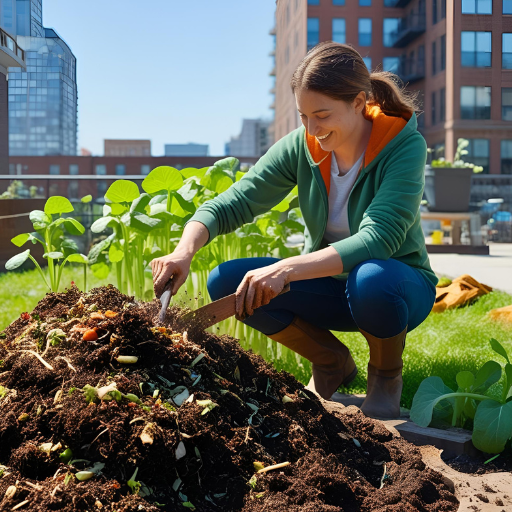Composting is one of the most eco-friendly and cost-effective practices you can adopt in your gardening journey. By turning kitchen scraps and garden waste into nutrient-rich soil, you not only reduce household waste but also improve the health of your plants naturally—without relying on chemical fertilizers.
In this guide, you’ll learn everything you need to know about creating your own organic compost at home, whether you have a backyard or live in an apartment.
Why Composting Matters
Before diving into the “how,” let’s explore the benefits of composting:
-
Reduces landfill waste: Organic materials make up a large portion of household garbage.
-
Improves soil structure: Compost boosts soil aeration, water retention, and texture.
-
Adds nutrients to the soil: It naturally provides nitrogen, phosphorus, potassium, and trace minerals.
-
Encourages beneficial microbes: Compost fosters healthy microbial life in the soil.
-
Saves money: No need to buy store-bought fertilizers.
Now let’s get started on how to make it!
What You Need to Start Composting
You don’t need a fancy setup to begin composting—just a few essentials:
1. Compost Bin or Pile
You can use a store-bought bin, build one with wood pallets, or simply start a compost pile in a shaded corner of your yard. For small spaces, compact bins or worm composting bins (vermicomposting) work well indoors.
2. Kitchen Scraps & Garden Waste
These are your composting materials. They fall into two categories:
-
Greens (Nitrogen-rich): Vegetable peels, fruit scraps, coffee grounds, tea bags, fresh grass clippings.
-
Browns (Carbon-rich): Dry leaves, paper towels, cardboard, shredded newspaper, straw.
Tip: A good compost pile needs a balance of greens and browns—ideally 1 part green to 2-3 parts brown.
3. Water & Air
Compost needs moisture and oxygen. You’ll need to water the pile occasionally and turn it to help air circulate.
What NOT to Add to Compost
Some materials can harm your compost or attract pests. Avoid:
-
Meat, dairy, or oily foods
-
Pet waste (especially from cats and dogs)
-
Diseased plants
-
Glossy or coated paper
-
Synthetic materials
-
Citrus peels in large amounts
How to Build Your Compost Pile: Step-by-Step
Step 1: Choose a Location
Pick a well-drained, partially shaded spot if you’re composting outdoors. If you’re in an apartment, choose a ventilated area like a balcony, under the sink, or laundry room with a closed compost bin.
Step 2: Layer Materials
Alternate layers of greens and browns:
-
Start with a layer of browns at the bottom (e.g., dry leaves or shredded cardboard).
-
Add a layer of greens (e.g., vegetable scraps).
-
Continue layering, keeping the ratio balanced.
Step 3: Add Water
Lightly water each layer. Your compost should be as moist as a wrung-out sponge—not soaking wet.
Step 4: Turn the Pile
Every 1–2 weeks, use a pitchfork or compost aerator to mix the pile. This introduces oxygen and helps materials break down faster.
Step 5: Monitor and Maintain
Your compost will start to break down over time. Keep an eye on:
-
Moisture: Add water if it’s dry, add browns if it’s soggy.
-
Smell: A healthy compost smells earthy. If it smells rotten, something is off balance (usually too many greens or not enough air).
-
Heat: Compost naturally heats up as microbes break down materials. This is a good sign of activity.
How Long Does Composting Take?
Compost can be ready in 2 to 6 months, depending on:
-
The size of your pile
-
The materials used
-
How often you turn it
-
Temperature and humidity
You’ll know it’s ready when it’s dark, crumbly, and smells like fresh earth.
How to Use Finished Compost
Once your compost is ready, you can apply it in several ways:
-
Mix into garden beds to enrich soil before planting.
-
Top-dress potted plants for a slow nutrient release.
-
Use as mulch around shrubs and flowers.
-
Feed your lawn by spreading thin layers over grass.
Avoid using unfinished compost, as it may rob nitrogen from your plants while it continues to break down.
Composting Without a Yard: Apartment Solutions
If you live in an apartment, you can still compost effectively:
1. Bokashi Bins
These bins ferment food waste using a microbial starter. They don’t produce traditional compost but create pre-compost that can be buried in soil or taken to a community garden.
2. Vermicomposting
Using worms (usually red wigglers) in a specially designed bin, you can turn scraps into nutrient-rich worm castings. It’s odorless when done right and perfect for indoor composting.
3. Composting Services
Some cities offer curbside compost collection or community drop-off points.
Tips for Successful Composting
-
Chop materials into smaller pieces for faster breakdown.
-
Avoid too much of one type of material, like all greens or all browns.
-
Keep a small compost pail in the kitchen for easy daily use.
-
Add crushed eggshells for calcium and better pH balance.
-
Cover food scraps with browns to avoid odors and pests.
Turning Waste Into Garden Gold
Making your own compost is one of the most satisfying and sustainable ways to support your garden. It turns everyday waste into “black gold” for your soil, helps the environment, and gives your plants the nutrients they crave—naturally.
Whether you have a spacious backyard or a tiny apartment balcony, there’s a composting method that fits your lifestyle. Start small, stay consistent, and in no time, you’ll be nourishing your garden with your own homemade compost.
